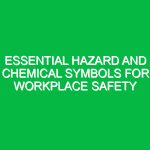Understanding Health and Safety in the HSE Domain
Health and safety, often abbreviated as H&S, is a critical component of the Health, Safety, and Environment (HSE) framework. This domain encompasses the policies, procedures, and practices that organizations implement to protect the health, safety, and well-being of their employees, clients, and the environment. In an era where workplace safety is increasingly scrutinized, understanding and implementing effective health and safety strategies is not just a legal requirement; it is a moral obligation that ensures a productive, efficient, and safe working environment.
A workplace that prioritizes health and safety cultivates a culture of prevention. This culture not only reduces accidents and injuries but also enhances employee morale, increases productivity, and ultimately leads to better organizational performance. In this article, we will explore essential health and safety strategies that can significantly contribute to a safer workplace.
Key Aspects of Health and Safety
1. Risk Assessment and Management
The foundation of any effective health and safety strategy is a comprehensive risk assessment. This process involves identifying potential hazards in the workplace, evaluating the risks associated with these hazards, and implementing measures to mitigate these risks.
- Identify Hazards: Hazards can be physical, chemical, biological, ergonomic, or psychosocial. Regular inspections and employee feedback are crucial in identifying these hazards.
- Evaluate Risks: Once hazards are identified, assess the likelihood of occurrence and the potential severity of harm. This will help prioritize which risks need immediate attention.
- Control Measures: Implement appropriate control measures to eliminate or minimize risks. This may include engineering controls, administrative controls, or personal protective equipment (PPE).
In a manufacturing facility, for instance, a risk assessment may reveal that workers are exposed to hazardous machinery. By implementing safety guards and providing training, the organization can significantly reduce the likelihood of injuries.
2. Safety Training and Education
Training is a vital component of any health and safety strategy. Employees must understand the hazards present in their work environment and the procedures in place to mitigate these risks. Regular training sessions should cover:
- Use of personal protective equipment (PPE)
- Emergency procedures and evacuation routes
- Specific safety protocols for machinery or hazardous materials
Consider a hypothetical situation in a chemical plant: a lack of proper training on handling hazardous substances could lead to serious accidents. However, through regular and thorough training programs, employees become equipped to handle such materials safely, reducing the risk of spills or exposure.
3. Incident Reporting and Investigation
An effective incident reporting and investigation process is essential for continuous improvement in health and safety practices. Organizations should encourage employees to report near misses and accidents without fear of retaliation.
- Encourage Reporting: Create a culture where reporting is seen as a positive action that contributes to safety.
- Investigate Incidents: Conduct thorough investigations to determine the root causes of incidents. This should involve looking beyond the immediate causes to identify underlying factors.
- Implement Improvements: Use the findings from investigations to make necessary changes to policies, procedures, or training programs.
For example, a manufacturing plant might experience a near miss where a worker narrowly avoids being struck by a falling object. By investigating the incident, management might discover that storage practices need to be revised, leading to the implementation of safer storage protocols.
4. Health and Wellness Programs
A holistic approach to health and safety encompasses not only physical safety but also mental and emotional well-being. Implementing health and wellness programs can significantly enhance employee morale and productivity. These programs may include:
- Health screenings and assessments
- Stress management workshops
- Fitness and nutrition initiatives
A real-life example can be seen in organizations like Google, which offers various wellness programs to its employees. By focusing on employees’ overall well-being, organizations can foster a healthier workforce that is more engaged and productive.
5. Emergency Preparedness
No workplace is immune to emergencies, whether they are natural disasters, fires, or medical emergencies. A comprehensive emergency preparedness plan is crucial in ensuring that employees know how to respond effectively in such situations.
- Develop Emergency Plans: Create clear, actionable emergency plans tailored to your specific workplace hazards.
- Conduct Drills: Regularly practice emergency procedures through drills to ensure employees are familiar with their roles.
- Provide Resources: Ensure that essential resources, such as first aid kits and emergency contact lists, are readily accessible.
An example of effective emergency preparedness can be found in hospitals, where staff undergo regular training on how to handle various emergencies, from fires to active shooter situations. This preparedness can save lives and minimize chaos during actual events.
Regulations and Standards in Health and Safety
Health and safety regulations are established to protect employees and the environment. Understanding these regulations is paramount for organizations to ensure compliance and foster a safe workplace.
Key Regulations Impacting Health and Safety
Some critical regulations include:
- Occupational Safety and Health Administration (OSHA): In the United States, OSHA sets and enforces standards to ensure safe working conditions. Employers are required to comply with these regulations or face penalties.
- Health and Safety at Work Act (HSWA): In the UK, the HSWA places a duty on employers to ensure the health, safety, and welfare of employees at work.
- International Organization for Standardization (ISO) 45001: This standard provides a framework for organizations to improve employee safety, reduce workplace risks, and create better working conditions.
Compliance with these regulations not only protects employees but also enhances an organization’s reputation and reduces liability risks.
Best Practices for Health and Safety
Implementing best practices in health and safety can significantly enhance workplace safety. Here are some effective strategies:
1. Foster a Safety Culture
Creating a safety-first culture starts at the top. Leadership should demonstrate a commitment to health and safety, setting a positive example for all employees. Regular communication about safety priorities and recognizing safe behavior can reinforce this culture.
2. Continuous Improvement
Health and safety is not a one-time initiative but an ongoing process. Organizations should regularly assess and update their policies, procedures, and training programs based on new risks, incidents, and feedback from employees.
3. Engage Employees
Involve employees in health and safety discussions. Their insights can be invaluable in identifying risks and developing solutions. Employees who feel their voices are heard are more likely to engage in safe practices.
4. Use Technology
Leverage technology to enhance health and safety management. Tools such as safety management software can help track incidents, manage training, and ensure compliance with regulations. Additionally, wearable technology can monitor worker exposure to hazards in real-time.
5. Regular Audits and Assessments
Conduct regular audits and assessments to evaluate the effectiveness of health and safety programs. These audits can help identify gaps in compliance and areas for improvement, ensuring that safety measures are always up to date.
Conclusion
In conclusion, implementing essential health and safety strategies is vital for creating a safer workplace. By focusing on risk assessment, training, incident reporting, health and wellness, and emergency preparedness, organizations can protect their employees and foster a culture of safety. Compliance with regulations and the adoption of best practices further enhance workplace safety.
As we navigate an ever-evolving work environment, it is crucial for organizations to prioritize health and safety as a fundamental aspect of their operations. By doing so, they not only comply with legal requirements but also contribute to a healthier, safer, and more productive workplace. Promoting health and safety is not just about avoiding accidents; it is about building an organizational culture that values the well-being of every employee.


